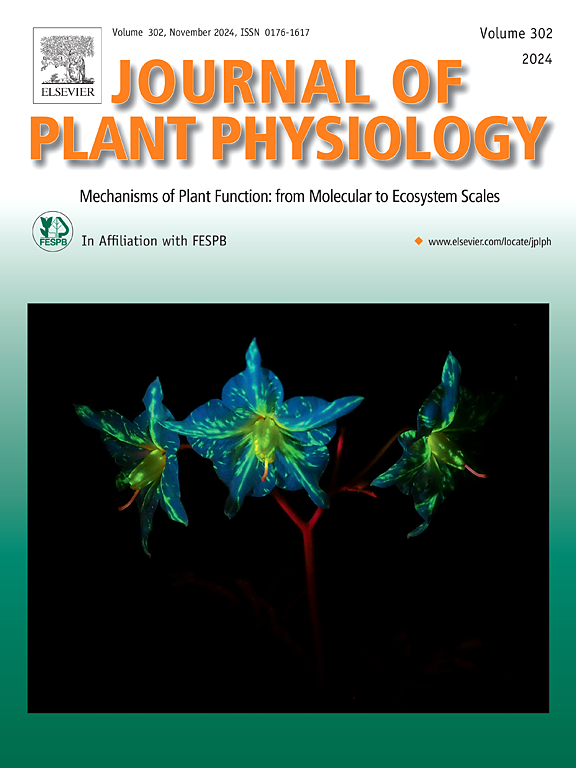Developmental-specific regulation promotes the free amino acids accumulation in chlorotic tea plants (Camellia sinensis)
IF 4
3区 生物学
Q1 PLANT SCIENCES
引用次数: 0
Abstract
Chlorophyll-deficient tea plant exhibits a significantly higher accumulation of free amino acids (FAAs) than normal tea plants. This study focused on the impact of leaf color and the developmental stage on FAAs in six tea germplasms while maintaining all other conditions. The total FAAs content initially increased as the leaf matured during the one-bud-two-leaves (1B2L) and one-bud-three-leaves (1B3L) stages in green germplasms, then decreased or stabilized in the one-bud-four-leaves (1B4L) stage. In contrast, chlorotic germplasms showed continuous FAAs' content increase from 1B2L to 1B4L, thus being significantly positively correlated with total chlorophyll content. Interestingly, ethylamine content decreased with leaf maturation in both chlorotic and green germplasms, thus showing a significant negative correlation with L-theanine content only in chlorotic germplasms. Comparative RNA-seq analysis linked FAAs accumulation in chlorotic germplasm's 1B3L to photosynthesis inhibition and in 1B4L to nitrogen assimilation promotion. Feeding experiments revealed higher L-theanine synthesis and degradation abilities in chlorotic shoots versus green shoots, with synthesis efficiency exceeding degradation efficiency. Overall, this study uncovers a developmental-specific FAAs accumulation pattern in chlorotic germplasms and offers novel insights into the precise regulation by leaf color and developmental stage.
发育特异性调控促进了萎凋茶树游离氨基酸的积累。
叶绿素缺乏茶树的游离氨基酸(FAAs)积累明显高于正常茶树。本研究在保持其他条件不变的情况下,重点研究了六种茶树种质的叶色和发育阶段对游离氨基酸的影响。在一芽二叶(1B2L)和一芽三叶(1B3L)阶段,随着叶片的成熟,绿色种质的 FAAs 总含量开始增加,然后在一芽四叶(1B4L)阶段减少或稳定。相比之下,叶绿体胚芽的 FAAs 含量从 1B2L 到 1B4L 阶段持续增加,因此与叶绿素总含量呈显著正相关。有趣的是,随着叶片的成熟,叶绿素和叶绿素种质的乙胺含量都有所下降,因此只有叶绿素种质的乙胺含量与左旋茶氨酸含量呈显著负相关。RNA-seq比较分析显示,叶绿体种质 1B3L 中 FAAs 的积累与光合作用受抑制有关,而在 1B4L 中则与促进氮同化有关。喂食实验显示,萎蔫芽与绿芽相比,L-茶氨酸的合成和降解能力更强,合成效率高于降解效率。总之,这项研究发现了叶绿芽中发育特异性的 FAAs 积累模式,并对叶色和发育阶段的精确调控提供了新的见解。
本文章由计算机程序翻译,如有差异,请以英文原文为准。
求助全文
约1分钟内获得全文
求助全文
来源期刊

Journal of plant physiology
生物-植物科学
CiteScore
7.20
自引率
4.70%
发文量
196
审稿时长
32 days
期刊介绍:
The Journal of Plant Physiology is a broad-spectrum journal that welcomes high-quality submissions in all major areas of plant physiology, including plant biochemistry, functional biotechnology, computational and synthetic plant biology, growth and development, photosynthesis and respiration, transport and translocation, plant-microbe interactions, biotic and abiotic stress. Studies are welcome at all levels of integration ranging from molecules and cells to organisms and their environments and are expected to use state-of-the-art methodologies. Pure gene expression studies are not within the focus of our journal. To be considered for publication, papers must significantly contribute to the mechanistic understanding of physiological processes, and not be merely descriptive, or confirmatory of previous results. We encourage the submission of papers that explore the physiology of non-model as well as accepted model species and those that bridge basic and applied research. For instance, studies on agricultural plants that show new physiological mechanisms to improve agricultural efficiency are welcome. Studies performed under uncontrolled situations (e.g. field conditions) not providing mechanistic insight will not be considered for publication.
The Journal of Plant Physiology publishes several types of articles: Original Research Articles, Reviews, Perspectives Articles, and Short Communications. Reviews and Perspectives will be solicited by the Editors; unsolicited reviews are also welcome but only from authors with a strong track record in the field of the review. Original research papers comprise the majority of published contributions.
 求助内容:
求助内容: 应助结果提醒方式:
应助结果提醒方式:


